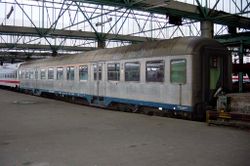
Silberling
Encyclopedia

Deutsche Bundesbahn
The Deutsche Bundesbahn or DB was formed as the state railway of the newly established Federal Republic of Germany on September 7, 1949 as a successor of the Deutsche Reichsbahn-Gesellschaft '...
, a type of regional passenger coach of which more than 7,000 units were built from 1958 to 1981. Nearly all of the coaches have undergone extensive modernisation – these modernised units are widely known as Mintling, Grünling ("greenling") or Rotling ("redling") after their exterior colours. The term Buntling ("colourling") is used to denote refurbished Silberling coaches in general.
Origin of the name
The term Silberling derives from the coaches' stainless steelStainless steel
In metallurgy, stainless steel, also known as inox steel or inox from French "inoxydable", is defined as a steel alloy with a minimum of 10.5 or 11% chromium content by mass....
body which gave them a unique look during their term of service. Translated it means "silverling" in the English language.
Technical data
| Total length: | 26,400 mm |
| Distance between bogie pivots: | 21,500 mm |
| Empty weight: | 42-47 t |
| Maximum speed: | 120 or 140 km/h (varies by type) |
| Number of seats: | 96 seats in second class in Bn coaches 2×24 seats in second and 30 in first class in ABn coaches. |
Type overview
| Type | Year built | Number | Notes |
|---|---|---|---|
| ABn 703 | 1959 – 66 | 798 | 5 cars with central control (ABnz 703), 20 cars with multi-voltage heating |
| ABnr 704 | 1965 – 67 | 34 | |
| ABnrz 704 | 1968 – 77 | 380 | |
| ABnrz 708 | 1977 | 1 | Karlsruher Versuchszug (Karlsruhe experimental train) |
| Bn 719 | 1969 – 76 | 1070 | |
| Bn 720 | 1959 – 63 | 1019 | |
| Bnz 723 | 1965/66 | 30 | Multi-voltage heating |
| Bnrz 723 | 1966 | 40 | |
| Bnrz 724 | 1969/70 | 180 | Field hospital car, steep roof |
| Bnrz 724.1 | 1989/90 | 18 | remodeled from Bnrz 725 |
| Bnr 725 | 1966 – 68 | 190 | |
| Bnrz 725 | 1967 – 77 | 449 | |
| Bnrz 728 | 1977 – 80 | 100 | Steep roof |
| Bnrz 729 | 1977 | 2 | Karlsruher Versuchszug (Karlsruhe experimental train) |
| Bnrz 734 | 1977 | 1 | Karlsruher Versuchszug (Karlsruhe experimental train) |
| BDnf 735 | 1978 – 81 | 71 | Rebuilt from BDnf 738, cab car w/o door |
| BDnf 738 | 1959 – 64 | 229 | Cab car with front passenger door, 20 cars with multi-voltage heating |
| BDnrzf 739 | 1969 | 40 | Cab car with front passenger door, cab removed later on |
| BDnrzf 740 | 1971 – 77 | 310 | Cab car, model Karlsruhe |
| BDn 742 | 1961 – 64 | 29 | no cab, rebuilt from BDnf 738, 20 cars with multi-voltage heating |
- Indicator z: Central control (Zugsammelschiene)
- Indicator r: disc brakes
See also
- Rail transport in GermanyRail transport in Germany, Germany had a railway network of 41,315 km. 19,857 km are electrified. The total track length was 76,473 km. Germany is a member of the International Union of Railways . The UIC Country Code for Germany is 80.-Overview:...
- History of rail transport in GermanyHistory of rail transport in GermanyGerman Railway history began with the opening of the steam-hauled Bavarian Ludwig Railway between Nuremberg and Fürth on 7 December 1835. This had been preceded by the opening of the horse-hauled Prince William Railway on 20 September 1831...

